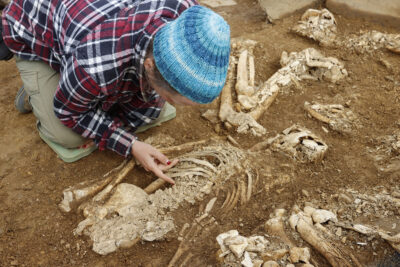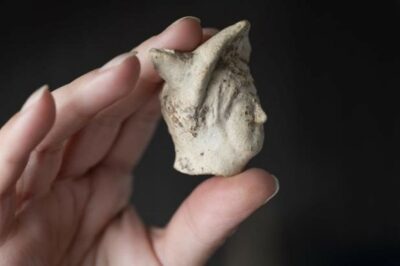2023 John Evans Fund Awards
-
Professor Vicki Cummings - In search of a lost passage grave: excavations at Blomar, Holm, Orkney
5000-year-old tomb discovered in Orkney!
Archaeologists have discovered the ruins of an incredibly rare 5000-year-old Neolithic tomb that was largely destroyed without record in the 19th century.
The three-week excavation at Holm, East Mainland, Orkney, directed by Dr Hugo Anderson-Whymark, National Museums Scotland, and Professor Vicki Cummings, Cardiff University, revealed traces of a substantial cairn over 15m in diameter that contains a stone structure accessed through a 7m long passage.
The surviving drystone walls revealed a large sub-rectangular stone chamber lay at the centre of the cairn. This was surrounded by six smaller side cells that once had corbelled stone roofs.
These features allow the tomb to be classed as a ‘Maes Howe-type’ passage grave. Only twelve tombs of this type are known in Orkney, including Maes Howe, Cuween and Quoyness. They are considered the pinnacle of Neolithic engineering in northern Britain.
Most of these tombs survive as upstanding monuments in Orkney, but the Holm tomb was buried beneath a pasture field as it was largely destroyed in the late 18th or early 19th century to supply building stone for a nearby farmhouse.
Further digging in the ruins by the farmer’s son in 1896 revealed traces of walling and located a stone macehead and ball, and eight skeletons. These discoveries were reported in The Orcadian by the local antiquary James Walls Cursiter, who speculated that the site was a ruined tomb.
The rare and unusual nature of the 1896 discoveries prompted the current search for the precise findspot so that the character of the earlier discoveries could be clarified. The current excavation targeting anomalies revealed on a geophysical survey undertaken in 2021.
Despite extensive modern disturbance, fourteen articulated skeletons of men, women and children and further disarticulated remains were located in one stone side cell.
Further human remains and artefacts, including pottery, stone tools and a bone pin, were recovered from the Victorian backfill of the tomb by students from the University of Central Lancashire and local volunteers.
Dr Hugo Anderson-Whymark says:
‘Orkney is exceptionally rich in archaeology, but we never expected to find a tomb of this size in a such a small-scale excavation. It’s incredible to think this once impressive monument was nearly lost without record, but fortunately just enough stonework has survived for us to be able understand the size, form and construction of this tomb.’
Prof Vicki Cummings says:
‘The preservation of so many human remains in one part of the monument is amazing, especially since the stone has been mostly robbed for building material. It is incredibly rare to find these tomb deposits, even in well-preserved chambered tombs and these remains will enable new insights into all aspects of these peoples’ lives.’

Image courtesy of National Museums Scotland
Notes:
1. The excavation was part-funded by grants from the Society of Antiquaries of London and Orkney Islands Council Archaeology Fund, and support from the University of Central Lancashire.
2. The 2021 Geophysical Survey was undertaken by Orkney Research Centre for Archaeology (ORCA)
-
Nathalie Cohen, National Trust archaeologist - Rare Roman head of Mercury discovered: excavations at Smallhythe Place in Kent
The excavation of the medieval site that was once used for shipbuilding has delighted archaeologists when they also came across earlier evidence of a Roman settlement.
As part of the discovery, finds from a Roman settlement in use between the 1st and 3rd centuries included the head of a figurine of the god Mercury, made from pipeclay, which experts believe to be “incredibly rare”.
Smallhythe Place in Kent, a site cared for by the National Trust, has been the subject of investigations for several years by archaeologists undertaking research on the shipyard by the river Rother which was one of the most significant Royal shipbuilding centres of medieval England.
Excavations which have taken place over the last three years have found evidence of medieval shipbuilding and breaking from the 13th-15th centuries. Over time, the site gradually silted up and the industry declined. However, the discovery of a previously unrecorded Roman settlement has excited the experts.
Religion was a central part of daily life in most Roman provinces, and statues as well as portable figurines of gods like the one discovered at Smallhythe were worshipped by both the Roman elite and the ordinary citizens in their homes.
Pipeclay figurines were made of clays local to central Gaul (modern-day France) and the Rhine-Moselle region and were imported, however most pipeclay figurines found in Britain are of female deities, the majority being of Venus.
Mercury was the god of all the fine arts as well as commerce and financial success, but while he is the most common god for metal figurines, pipeclay examples are extremely rare, with less than ten so far found from Roman Britain.
Nathalie Cohen explained:
“Our excavations at Smallhythe revealed previously undiscovered Roman activity, dating from the 1st-3rd centuries AD, where we found tiles stamped with the mark of the Roman fleet (the Classis Britannica), ceramics including an intact pot, and evidence for buildings, boundary features and pits – which provide tantalising clues to the nature of this riverside community.
“But to come across a head of a figurine of Mercury, in pipeclay, is incredibly rare. Just 5cm tall, the head is clearly visible as Mercury, with his winged headdress. We sadly did not find the remaining part of the figurine.”
The complete figurine probably would have depicted Mercury standing, either draped with a chlamys (a short cloak), or naked, holding a caduceus (a staff with two intertwined snakes).
Dr Matthew Fittock, an expert on ceramic figurines in Roman Britain, commented:
“Pipeclay figurines were mainly used by civilians for private religious practice in domestic shrines and occasionally in temples and the graves of often sick children.
“Rather than pieces being discarded because they were broken, there is evidence to suggest that deliberately breaking some figurine heads was an important ritual practice, whereas whole figurines are usually found in graves. Few single pipeclay heads are known in Britain, some of which may have been votive offerings. Finds like this at Smallhythe provide an extremely valuable insight into the religious beliefs and practices of the culturally mixed populations of the Roman provinces.”
Funding for the excavations at Smallhythe Place was generously provided by the National Trust’s Roman Research Fund, the Robert Kiln Fund, the Society of Antiquaries, the Royal Archaeological Institute and the William and Edith Oldham Charitable Trust.
The Mercury head along with other finds from the excavation will go on show from 28 February at Smallhythe Place. For more information and opening times visit their website here.
